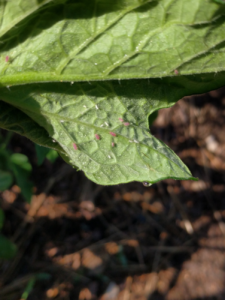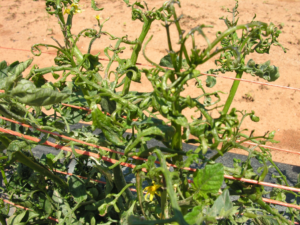Curling Tomato Leaves? Here’s What to Know!
go.ncsu.edu/readext?712007
en Español / em Português
El inglés es el idioma de control de esta página. En la medida en que haya algún conflicto entre la traducción al inglés y la traducción, el inglés prevalece.
Al hacer clic en el enlace de traducción se activa un servicio de traducción gratuito para convertir la página al español. Al igual que con cualquier traducción por Internet, la conversión no es sensible al contexto y puede que no traduzca el texto en su significado original. NC State Extension no garantiza la exactitud del texto traducido. Por favor, tenga en cuenta que algunas aplicaciones y/o servicios pueden no funcionar como se espera cuando se traducen.
Português
Inglês é o idioma de controle desta página. Na medida que haja algum conflito entre o texto original em Inglês e a tradução, o Inglês prevalece.
Ao clicar no link de tradução, um serviço gratuito de tradução será ativado para converter a página para o Português. Como em qualquer tradução pela internet, a conversão não é sensivel ao contexto e pode não ocorrer a tradução para o significado orginal. O serviço de Extensão da Carolina do Norte (NC State Extension) não garante a exatidão do texto traduzido. Por favor, observe que algumas funções ou serviços podem não funcionar como esperado após a tradução.
English
English is the controlling language of this page. To the extent there is any conflict between the English text and the translation, English controls.
Clicking on the translation link activates a free translation service to convert the page to Spanish. As with any Internet translation, the conversion is not context-sensitive and may not translate the text to its original meaning. NC State Extension does not guarantee the accuracy of the translated text. Please note that some applications and/or services may not function as expected when translated.
Collapse ▲Tomatoes are probably the most popular vegetable crop to grow. I probably get more questions about tomatoes than about any other vegetable crop. This year, the most common question about tomatoes from gardeners has been “Why are my tomato leaves curling?” Like many questions in gardening, this has more than one answer.
Why are their leaves curling?
Environmental stress is the most common reason for tomato leaves to curl. Tomato leaves certainly curl from drought stress, but they can also curl if the plant gets too much water. Hot temperatures can cause tomato leaves to curl. Excessive nitrogen fertilization will also cause tomato leaves to curl. Excessive nitrogen will have another side effect, as it can favor the growth of new leaves and shoots at the expense of setting fruit. In some cases, heavy pruning or damage to roots may also cause leaf curl.
Environmental Factors

If tomato leaves are curling due to environmental factors, usually the older leaves will show signs first. Leaves will bend upward and leaflets will curl inward. Leaflets may look thick and leathery.
Variety
The degree of curling depends on the tomato variety. Heirloom varieties may have more leaf curl than hybrid tomatoes. Indeterminate varieties often show more leaf curl than determinate varieties.
Insect Damage

Tomatoes may also show curled leaves from insect damage. Heavy feeding by aphids may cause the leaves to curl, as the insects suck plant juices out of the leaves. Look on the undersides of leaves to find the insects. Use insecticidal soap to control infestations of aphids.
Herbicide Drift or Contamination

A less common reason for curling tomato leaves is herbicide drift or contamination of compost by herbicide residue. It’s easy to understand how herbicide drift can happen. Your neighbor sprays a weed killer, or possibly you spray it yourself. Maybe there’s a slight breeze, or the area that is sprayed is just a little too close to your vegetable garden. Herbicide residue drifts over to the tomato plants, and the plants are damaged.
However, another way for herbicide damage to happen is through contaminated compost or yard clippings. Lawns and pasture grasses are often treated with herbicides. The herbicides can still be present in grass clippings from treated lawns and even in manure from animals that have eaten the treated pasture grass. If these grass clippings and manure are incorporated into compost, there can be herbicide carryover. Plants grown in soil amended with the compost may exhibit abnormal growth and be stunted.
Tomato plants damaged by herbicide will often have twisted growth. Leaves will roll downward. The stems may turn white and may even split. Damage is often more noticeable on new growth. Sometimes the tomato plants can grow out of the damage and produce normally. But if tomato plants are been subjected to a high dose of herbicide, then they may never recover and should be discarded.
How do you tell the cause of the damage? If you suspect herbicide damage due to carryover in compost, the simplest way to diagnose this is by doing a bioassay. You will need a sample of the compost, potting soil, pots, and either tomato transplants or tomato seeds to do a bioassay.
Mix the compost with potting soil and fill half the pots with the mixture. Fill the remaining pots with potting soil only. Label the pots so you know which have compost and which have only soil. Plant the tomato transplants or tomato seeds in the pots and place them in a sunny window. Keep watered and monitor the germination of the seeds or the growth of the plants. Let the plants grow for about three weeks and evaluate their growth. If the plants that are grown in the potting soil-compost mixture look twisted, stunted, or discolored while the plants grown in only potting soil look healthy, there is a good chance that your compost has herbicide carryover.
The Good News!
The good news is that eventually, the herbicide will break down. You can leave fallow the garden beds with the compost incorporated into the soil for a growing season or two. Or you can rotate those areas into a crop that is less sensitive to the herbicide, such as kale or turnips. Tomatoes, cucumbers, spinach, and beans are the vegetable crops most sensitive to herbicides. You can also keep the area in a cover crop for a season or two.




